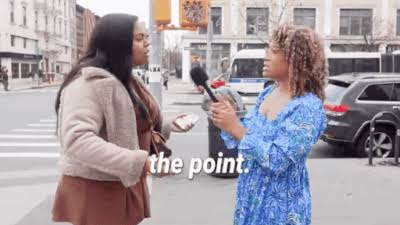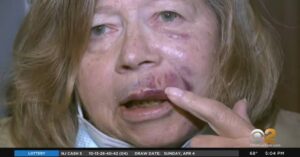Woman Speaks Out After Being Sucker: Punched Live on Camera,From Interview to Assault

The viral street is afraid of sucking more attacks in the interview; Charlie cites Kirk … Woman accused of attack, Brian rivers. Today we will discuss about Woman Speaks Out After Being Sucker: Punched Live on Camera,From Interview to Assault
Woman Speaks Out After Being Sucker: Punched Live on Camera,From Interview to Assault
In an era where public discourse is often played out in real time, and media cameras capture almost every moment, few incidents provoke as much shock as watching someone being assaulted live. Recently, a viral video captured such an incident: a woman conducting a street interview was suddenly and violently struck — a sucker punch — mid-conversation, live on camera. The aftermath of that moment has ruptured lives, ignited public debate over political violence, due process, and the safety of women in public discourse.
This article explores the full arc of that episode: the background, the on-camera assault, the victim’s response, legal fallout, public reaction, and the broader implications for media, safety, and justice.
The Incident: From Interview to Assault

The Setup: On-Street Interview
On April 3, 2025, Savannah Craven Antao, a pro-life influencer and reporter affiliated with the advocacy organization Live Action, was conducting a street interview in Harlem. Her conversation partner was a woman responding to questions about abortion, Planned Parenthood, and foster care. The discussion was heated but still within the bounds of discourse — up until the moment of violence.
Savannah’s husband, standing close by, filmed the entire encounter. The video shows that mid-discussion, the woman being interviewed abruptly lunged forward and struck Savannah in the face — not once, but twice — without visible warning or provocation. The blows were delivered swiftly, and the assailant then walked away.
In the footage, you see the victim reel backward, blood streaming, stunned, and the assailant departing, making an obscene gesture at the camera.
The Aftermath: Physical and Psychological Toll
Savannah Craven Antao sustained visible injuries: two lacerations requiring stitches, bruising around the eye, swelling, and facial trauma. She later disclosed experiencing vivid flashbacks, anxiety, and emotional distress — the psychological scars proving almost as real as the physical damage. In her own words, she called the attack “terrifying.”
The viral nature of the video meant that every replay, every share, reopened the wound. She said she would see the footage repeatedly on social media, reliving the moment. The emotional weight, the humiliation, the violation—all intensified by millions watching.
The Victim Speaks: Finding Her Voice Amid Trauma
Public Statement and Reaction
In the days following the assault, Savannah came forward publicly. She demanded accountability, pressed for legal action, and insisted the act was not isolated but symptomatic of a growing climate of violence toward outspoken figures.
She expressed shock and hurt at how the system responded — especially when she learned that the criminal case would later be dropped. he described feeling betrayed by a system she believed should protect victims.
Savannah also framed her response within the broader political climate. She claimed she would not be deterred from raising difficult issues, even in the face of physical risk. She voiced concern that her attacker’s conduct was part of a disturbing pattern of political violence toward those with conservative or pro-life views. She also said that, paradoxically, the incident reinforced her commitment to her work
Personal Cost and Resilience
Behind the media statements, Savannah has had to grapple with nightmarish personal consequences. The physical pain, recovery, doctor’s visits, and scarring were burdensome. The emotional and mental cost — sleep disruption, traumatic flashbacks, anxiety in public spaces — added another layer of suffering.
Yet, even amid this turmoil, she has been consistent: she wants justice, but also wants awareness. She has called for other women and interviewers to take safety precautions. She has warned that nobody — especially women — should feel silenced simply by fear. She has asked for prayers or healing not just for herself, but (in a complex posture) also for the assailant, whom she thinks must be suffering in their own way.
Legal Journey: The Case That Faltered
Arrest, Charges, and Initial Hope
Shortly after the attack, New York police arrested Brianna J. Rivers, 30, on suspicion of second-degree assault. She was formally charged with one count of second-degree assault. There was public attention and expectation that the case would move forward. Her GoFundMe campaign to raise funds for her legal defense was also launched, though it was later removed for violating rules regarding fundraising for violent crime legal defense. Rivers claimed, in her own social media posts, that she had been provoked and apologized — though not entirely unreservedly, as she blamed part of the narrative framing on Savannah. She also lost her job after the incident.
The Collapse: Dropped Charges
In July 2025, prosecutors dropped the criminal case — not because Rivers was found innocent or because of lack of evidence, but rather because the Manhattan District Attorney’s (DA’s) office missed a critical legal deadline related to discovery and filing. The DA’s office admitted it failed to submit a certificate of readiness in time, effectively allowing the case to time out under procedural rules. The error was attributed internally to the reassignment of the case between prosecutors.
Savannah found out not through official notification, but via her attacker’s social media post — a cruel irony. The DA’s office issued a statement apologizing for “an unacceptable error” and pledged internal reforms, including creation of a Discovery Compliance Bureau to prevent similar lapses.
To critics and legal observers, the development was infuriating: a seemingly straightforward case of assault, captured on video, dismissed because of bureaucratic negligence.
Civil Recourse and Next Steps
Although the criminal case was dropped, Savannah is reportedly pursuing a civil lawsuit (tort claim) against the assailant, seeking financial compensation and formal accountability. Some legal commentators see this as her only viable route now.
Observers, however, caution that civil suits — though valuable symbolically — rarely provide full justice or deterrence for political violence. Victims often face high costs, burdens of proof, and obstacles, especially when criminal systems flounder.
Public Reaction and Broader Debate
Media, Partisanship, and Perception
The case quickly became a lightning rod in political discourse. Supporters of Savannah portrayed her as a martyr for free speech under attack by ideological opponents. Critics questioned whether she provoked the assault, or whether her style of interviewing stoked tension. The injured woman’s perspective, however, resonated widely: that violence, especially against outspoken women, must not become normalized.
Some media coverage highlighted the irony: that someone conducting journalism could become the subject of physical violence, live on camera, and then be failed by the legal system. Others flagged it as a test case for how prosecutors treat politically charged attacks—and whether ideology influences discretionary decisions.
Political Violence and Safety of Voices
This case is not isolated. In recent years, people holding controversial or polarizing views—whether on abortion, politics, race, or religion—have faced harassment, threats, and occasional violence. The question raised: at what point does “disagreement” transition to criminal assault? How safe are those who speak publicly on fraught issues?
Some activists and commentators framed Savannah’s assault as emblematic of an intensifying intolerance for dissenting views. Others cautioned against conflating all activism or heated speech with vulnerability to violence — there must still be accountability on both sides.
The case also reopened discussions around gendered violence: women in public roles — especially those holding strong opinions — may face disproportionate anger, threats, or aggression. The fact that this assault was captured on camera but still allowed to fade legally magnifies worries over systemic protection.
Legal Accountability and Trust in System
Public confidence in law enforcement and prosecution is often tied to how visibly they address clear wrongdoing. When a case such as this — video evidence, identifiable parties — is dropped over procedural missteps, it fuels skepticism that political or institutional biases might play a role. Critics accused the DA’s office of undervaluing victims in favor of convenience or optics. The DA’s acknowledgment of internal error and reforms was necessary but seen by some as too little, too late.
Advocacy groups and legal analysts argue that systems must be reformed to ensure victims are not further victimized by bureaucratic failure.
Lessons, Precautions, and Moving Forward
For Interviewers and Public Figures
-
Always film with redundancy — multiple angles, backup audio, witness presence. In cases of assault or threats, video may be the only exculpatory evidence.
-
Pre-event safety planning — have exit strategies, safe distance, team support, and possibly security presence in higher-risk settings.
-
Rapid reporting protocols — if attacked, involve police immediately, preserve evidence (clothing, cameras, time stamps) and seek medical documentation.
-
Mental health support — assaults carry emotional trauma; victims should access counseling and support networks early.
For Legal and Prosecutorial Systems
-
Strict procedural compliance — procedural deadlines (discovery, readiness certificates, filings) must not be allowed to derail meritorious cases.
-
Victim notification and transparency — victims should be informed promptly of any case changes or dismissals, instead of learning by chance or social media.
-
Special advocacy units — DA offices could dedicate teams to ensure politically sensitive cases are handled with care and oversight.
-
Civil remedies awareness — where criminal justice fails, victims must know their civil options and have access to legal aid.
For Public Discourse and Culture
-
Civility over outrage — promoting respectful disagreement as a norm, and condemning violence regardless of ideology.
-
Support for free expression — protecting the physical safety of those who speak publicly, especially women and minorities, is critical to open discourse.
-
Critical media consumption — audiences should scrutinize not only the act but how systems respond, how media narrates, and whether norms shift with bias.
Conclusion
What began as a street interview devolved into a moment of raw violence — captured for the world to see — and revealed deeper fractures: in trust, justice, civility, and safety. The woman at the center of this episode, Savannah Craven Antao, has spoken out not only about her pain, but about what it means when an assault becomes a test of our institutions and values.
Her experience is both unique and universal: unique in its particulars, but emblematic of the dangers that can lurk when public voices clash, especially where passion and ideology converge. Whether justice will be served is still unsettled; but her courage in speaking out underscores an essential principle: that no one doing the public work of engagement should live in fear of violence.
How useful was this post?
Click on a star to rate it!
Average rating 0 / 5. Vote count: 0
No votes so far! Be the first to rate this post.
About the Author
usa5911.com
Administrator
Hi, I’m Gurdeep Singh, a professional content writer from India with over 3 years of experience in the field. I specialize in covering U.S. politics, delivering timely and engaging content tailored specifically for an American audience. Along with my dedicated team, we track and report on all the latest political trends, news, and in-depth analysis shaping the United States today. Our goal is to provide clear, factual, and compelling content that keeps readers informed and engaged with the ever-changing political landscape.




